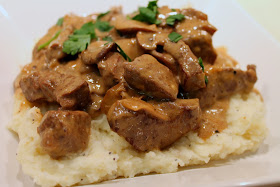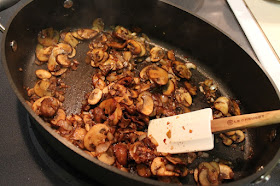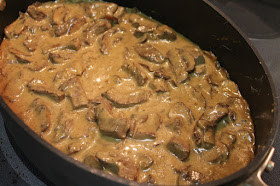If Beef Stroganoff could be the subject of a biographical film, it would be a grand epic, spanning decades, continents and wars. It would have its moments of tragedy, a little infidelity (bear with me on that one) and possibly a downer ending: Daily Meal included it on its recent list of 11 dishes disappearing from restaurant menus.
 |
| Sirloin is a tender, lean cut good for Beef Stroganoff because the dish is not cooked long. Be careful not to overcook it, or it will become tough. |
Like the Grouper Almondine, I wanted to explore whether Beef Stroganoff is worthy of a new chapter. My impression of the dish is that it is not haute cuisine: chunks of beef mixed with sour cream and served over noodles sounds rather dowdy frankly. But when I looked into its background, I learned that it has a surprisingly rich history.
 |
| Sirloin, cut into 2-inch strips prior to searing. |
The dish emerged in Russia during the 19th century and is likely named for Russian statesman Count Pavel Alexandrovich Stroganov, as was the fashion to name a dish after the household it was created for. Sources say the exact origins of the dish are unconfirmed. Some point to French chef Charles Briére, who was working in St. Petersburg and submitted it for publication in L’Art Culinaire in 1891. Other sources indicate the dish was in the Stroganov family for some time and appeared in the 1861 Russian cookbook A Gift to Young Housewives by Elena Ivanovna Molokhovets. Regardless, I like to imagine this is the sort of thing Anna Karenina would have sat down to eat at dinner.
After the subsequent fall of the Russian aristocracy, the dish traveled to China, where it was popular in restaurants and hotels prior to World War II. Immigrants and American military personnel stationed abroad brought the dish back to the United States, where its popularity grew and peaked during the 1950s, ironic considering this was also the height of the Cold War. This is also when the once elegant dish became troubled. High costs of meat during the war sent cooks in search of cheaper, lesser quality cuts. American home cooks looking for shortcuts turned to the burgeoning processed food industry, leading to recipes for Beef Stroganoff that included ingredients like cream of mushroom soup and ketchup. Anna Karenina would not have been happy.
 |
| Because the meat will be heated again, it does not need to be fully cooked during the searing step. |
For my take on the dish, I wanted the honor the dish’s history, taking it back to a more traditional form. I was intrigued by its French origins. Blogger Jennifer Eremeeva (from Dividing My Time; she now writes Russia Lite and The Moscovore) describes Beef Stroganoff as an adaptation of beef fricassee and offers a good traditional recipe. For my dish, I turned to the definitive American voice on French cuisine for ideas.
In Mastering the Art of French Cooking, Julia Child describes Sauté de Boeuf à la Parisienne as a French version of Beef Stroganoff. Perfect! The recipe’s simplicity is what drew me to it to use as the blueprint for my dish. Although her book is notorious for its hours-long recipes, this one is surprisingly quick—she claims it can be done in 30 minutes. And it uses just 12 ingredients, including salt and pepper. I also used elements of the recipe by America’s Test Kitchen, which is always a useful source for good technique.
 |
| Instead of flour or cornstarch, I thickened the sauce with arrowroot powder which is less cloudy and has little flavor. |
Traditional Beef Stroganoff
Adapted from Sauté de Boeuf à la Parisienne from Mastering the Art of French Cooking by Julia Child and Skillet Beef Stroganoff by America’s Test Kitchen
2 tbsp. unsalted butter
1 ½ lb. sirloin steak, pounded to ½ inch thickness and cut into strips 2 inches long by ½ inch wide.
12 oz. sliced cremini mushrooms
Seasoned salt, to taste
2 shallots, minced (about ¼ cup)
¼ cup madeira
3 cups beef broth
2 tsp. arrowroot powder mixed with 2 tsp. waster.
Fresh-ground black pepper, to taste
½ cup sour cream
Everything Mashed Potatoes (see recipe below)
2 tbsp. chopped Italian parsley (garnish)
1. Heat 1 tbsp. butter in a large skillet over medium-high heat. Sear beef in batches 2-3 minutes per side, turning once, about 4-6 minutes total. Repeat until all the meat is browned. Remove meat from pan and set aside.
2. Melt 1 tbsp. butter to skillet. When foaming subsides, add mushrooms, season with seasoned salt to taste, and sauté for about 3 minutes. Add shallots and continue cooking until mushrooms and shallots are browned, about 6-7 minutes total. Remove from pan.
3. Deglaze pan with madeira, stirring to remove any remaining browned bits. Add beef broth, increase high and bring to a boil. Boil liquid until reduced by half. Reduce to medium. Return beef and mushroom mixture to pan, reduce heat and simmer, covered, until the meat is cooked but still tender, about 12-15 minutes. During the last couple minutes of cooking, add the arrowroot-water mixture and stir to thicken the sauce as it cooks. Turn heat to low. Season with fresh-ground black pepper and, if desired, additional seasoned salt. Stir in the sour cream. When heated through, turn off the heat. Serve over mashed potatoes topped with fresh chopped Italian parsley.
Everything Mashed Potatoes
Inspired by Range
We recently had Everything Mashed Potatoes as a side dish at Range, and I thought they would make a more interesting accompaniment for Beef Stroganoff than plain mashed potatoes. Apparently I’m not the only one, as an online search turned up a number of recipes. Some people got lucky and found an “everything bagel” spice blend, but since I couldn’t, I had to come up with one (which I did by studying the ingredients list of the Everything Bagel at Whole Foods).
3 large russet potatoes, unpeeled and cut in half
4 tbsp. unsalted butter, room temperature
2 tsp. dried minced onion
1 tsp. dried minced garlic
1 tsp. toasted sesame seeds
¼ tsp. poppy seeds
Seasoned salt, to taste
2/3 cup milk (may use skim)
1/3 cup sour cream
Put potatoes in a large pot and fill with water until covered by 1 inch. Bring to boil and cook potatoes until easily pierced with a paring knife. Drain potatoes, allow them to cool a bit and pass through a potato ricer into a large bowl (when using a potato ricer, the potato skins should stay in the ricer). Add butter to potatoes and stir to combine. Add minced onion, minced garlic, sesame seeds, poppy seeds and seasoned salt. Heat milk in the microwave or in a saucepan over medium heat (if you do this on the stove, heat the milk while the potatoes are cooking). Pour milk over potato mixture, add sour cream and stir to combine thoroughly.







Anna would be pleased with your reinvention. (Especially those amazing mashed potatoes!) Nicely done.
ReplyDeleteSpasibo.
ReplyDelete